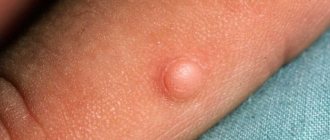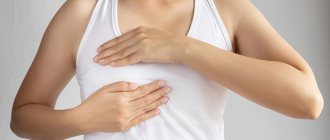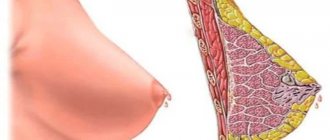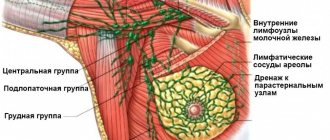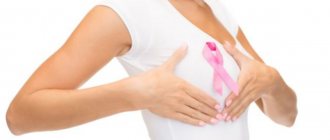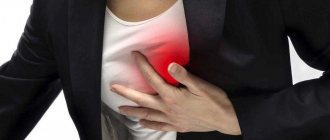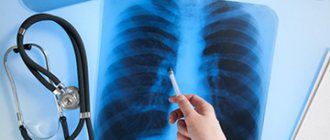Pathology of the mammary glands in the form of fibrocystic transformation is called mastopathy . This disease is classified as a female disease, although men also have similar conditions. In representatives of the stronger sex, the mammary glands are more often affected during adolescence. But sometimes painful lumps occur at other ages (including childhood and old age).
All benign diseases of the mammary glands in men that occur with tissue hypertrophy are called gynecomastia (see Fig. 1).
Rice. 1 - Hypertrophy of the mammary glands in men - gynecomastia (before and after surgery).
Classification of the disease
Bilateral mastopathy in a man
Mostly, men do not even suspect that they can get mastopathy or, as it is also called, gynecomastia. The pathology is very serious, since it causes the mammary glands to begin to grow in men.
Mastopathy is divided into two types: false and true.
With the true type of the disease, damage occurs to the tissue of the gland, which occupies most of the male breast. During this process, it can increase significantly.
The false one has a significant difference; it only affects adipose tissue. The disease often appears in overweight men.
There are cases when false and true mastopathy are combined.
Diagnosis of breast cyst
Mammologists detect a breast cyst during palpation. The diagnosis is confirmed using ultrasound and mammography (breast x-ray).
Ultrasound examination of the breast allows you to visualize and differentiate superficial and deep cysts with a size of less than 5 mm with an accuracy of 85-95%. During ultrasound examination of the mammary glands, ultrasonic vibrations reflected from tissues with different densities are recorded by a sensor and converted into digital signals that reproduce an image of the anatomical area being studied on the monitor. When diagnosing fibrocystic mastopathy and breast cysts, ultrasound examination is superior in sensitivity to x-ray mammography. During the examination, sonologists can identify small cysts and nodules that are inaccessible to palpation through the skin, and altered regional lymph nodes. Since cyclical changes occur in the structure of the mammary glands associated with hormonal activity, ultrasound examination of the mammary glands is carried out in the first phase of the menstrual cycle (from the fifth to the tenth day).
During an ultrasound examination of the mammary glands during cyst inflammation, doctors see swelling of the tissue. With a purulent cyst of the mammary gland, a limited formation is visible with a focus of purulent melting and inflammatory edema around. An uncomplicated breast cyst is defined as a round, fluid-filled neoplasm.
The diagnosis of a breast cyst is confirmed by puncture with collection of contents for analysis. With a purulent cyst, the contents will be cloudy and thick. If a doctor suspects breast cancer during an ultrasound examination, he will confirm or rule out the diagnosis using a biopsy. The material obtained using fine-needle aspiration biopsy is sent for cytological examination. Aspirate from uncomplicated cysts does not contain cells. Pus in the contents of the cyst indicates inflammation. ;
Mammologists use X-ray film and digital mammography to diagnose breast diseases. During a film study, the image is recorded on X-ray film, and during digital mammography, it is displayed on a monitor screen, stored in the computer’s memory, and processed using various programs. Digital mammography is most informative when there is a high density of breast tissue.
When interpreting mammography results, the radiologist takes into account clinical and anamnestic data. When assessing mammograms, it examines the structure of adipose and glandular tissue, vessels, and ducts. When identifying pathological foci, it establishes their number, size, location, shape, outline, symmetry, and homogeneity. Cysts on mammography are defined as oval or round formations that are clearly demarcated from healthy tissue. In breast cancer, the detected shadows have unclear contours, spiny or radiant boundaries.
Gynecomastia
In some cases, mastopathy in men occurs due to banal weight gain. So in medicine, this reason gave the basis for the disease gynecomastia. This can be caused by several reasons:
Diagnosis: what is the doctor looking at the chest in the chest?
In case a female doctor first examines and counsels the patient, the diagnosis is based on information about the age of the persons affected, their medical history and possible health problems in their family. The doctor also specifically asks a question about the woman’s hormonal situation: has she given birth to children? Or is it unwanted or unintentionally childless? If monthly bleeding is present: how does this happen with this and with the cycle as a whole? If in menopause: is there any other complaint? Has this person participated in cancer screening?
- overweight;
- sudden increase in body weight;
- alcohol consumption;
- ignoring sports activities;
- lack of a sexual partner;
- lack of regular sexual intercourse.
The last point, as strange as it may seem, plays an important role. With constant contact with the opposite sex, a man’s body produces progesterone, which speeds up metabolism and promotes cell renewal. It also stimulates the production of other male hormones necessary for fertilization. Due to excessive alcohol consumption, a man can even become a “carrier” of dead cells that are not capable of procreation.
Therapy: varies
In addition, a physical examination as well as imaging studies such as breast, mammogram, possibly one of the breasts. In case of unclear or suspicious results, the doctor also recommends examiners. Treatment depends on an accurate diagnosis. The range of therapy is roughly sketched out, from waiting to observe and control one, such as a cyst, to removing the tumor.
Smaller changes can often be completely eliminated using modern biopsy technology. Sometimes, however, it is inevitable to follow the breasts or remove them altogether. The removed tissue is then carefully examined under a microscope. Additional treatment, such as one, may be required. Additional treatment is often required.
Mastopathy is characterized by breast enlargement and the presence of compactions in the area of the glands. Within 2-3 months, the growth of these seals is noticeable. If neoplasms are characterized as adipose tissue, then according to the structure and consistency of the gland cavity, it is filled with a fatty layer of a hard and dense type. When such growths are detected, it is painful for a man to sleep on his chest; any touch is accompanied by pain and an unbearable burning sensation.
Pain also indicates the type of disease, since sharp pain and then subsiding (after a month) indicates the development and growth of glandular tissue. If the pain is dull and aching, then fatty and connective tissue is growing, which is not so scary for a man regarding this issue.
If the mammologist (he also examines men) detects growth of glandular tissue, the man will need surgery.
In the female body, removal would not be prescribed, since the physiological structure of the tissues is different; in men, it is necessary, although this does not entail long-term treatment and hospital stay. I would also like to note that men will not be as “offended” if they lose part of the gland than a woman. Therefore, the question of surgery never becomes a problem for the stronger half of humanity.
Mastitis in men - symptoms, treatment. Why it occurs and how to avoid it
Inflammation of the breast tissue, which usually develops in women during lactation, is called mastitis. However, the disease can occur not only in women, but also in men.
Mastitis in men is quite rare and has its own characteristic symptoms. Treatment for inflammation of the mammary glands in men is practically no different from the treatment of mastitis in women.
Causes
Male mastitis occurs as a result of the penetration of pathogenic microorganisms into the breast tissue.
They enter the mammary gland through skin lesions, as well as through the bloodstream from other foci of infection in the body.
There are a number of factors that can trigger the development of mastitis in men. These include:
- gynecomastia
- diabetes
- tumors in the genitals
- beer abuse
- mechanical damage to the mammary glands
- hypothermia
- weak immunity
- use of anabolic steroids during bodybuilding
Very often, inflammation of the mammary glands in men occurs as a result of hormonal disorders in the body. For example, a malfunction of the hormonal system can lead to a decrease in testosterone levels in the body, which, in turn, provokes the development of mastitis.
It is also necessary to control the content of female hormones (estrogens, progesterone) in the male body. An increase or decrease in their levels can also lead to inflammation of the mammary gland.
How it manifests itself
Symptoms of mastitis depend on the stage of its development:
1. Serous stage.
The clinical picture at this stage is weak. There is a slight enlargement and swelling of the mammary gland, and mild discomfort appears. Upon palpation of the lesion, a compaction is detected. At the end of this stage of the disease, the lymph nodes begin to enlarge.
2. Infiltration stage.
Develops in the absence of timely treatment of the disease. The above symptoms increase, swelling becomes greater, chest pain intensifies, temperature rises, the patient’s well-being worsens, symptoms of intoxication of the body appear, nearby lymph nodes are enlarged.
3. Purulent stage.
The symptoms are pronounced. The lesion is filled with pus. There is an increase in temperature to 39-40 degrees, severe intoxication begins, the affected mammary gland changes shape and shape.
Palpation reveals a hot, pulsating, painful lump in the chest, the skin over it is swollen and reddened. The axillary lymph nodes enlarge and become painful.
Without treatment, the pathological process in the body progresses, and inflammation in this case can only be eliminated through surgery.
Treatment
When the first signs of the disease appear, you should immediately contact a specialist (endocrinologist, surgeon, mammologist) and undergo an examination. The doctor will tell you how to treat mastitis after examining the patient and receiving test results.
In men, treatment of mastitis depends on the stage of the disease, clinical picture, and general condition of the patient.
Conservative treatment of mastitis
Prescribed in the first two stages of the disease (serous and infiltrative). Therapy includes taking antibacterial drugs, vitamins, and immunostimulating agents. The patient is also prescribed symptomatic treatment (analgesics for pain relief, antipyretics for high temperatures, and so on).
After the temperature subsides, physical therapy helps.
Each case of the disease has its own causes and requires an individual approach, so self-medication is unacceptable. If a course of antibiotic therapy does not produce results, the patient is hospitalized and further treatment is carried out in a hospital setting.
Surgery
Indicated for purulent inflammation of the mammary glands. The surgeon opens the formed abscess and drains the source of inflammation. After this, a course of conservative treatment is prescribed, including antibiotics and analgesics.
Treatment of mastitis in men at home
It should be remembered that any self-medication is prohibited! When the first symptoms of mastitis appear, you should immediately consult a doctor who will prescribe adequate treatment depending on the causes of the disease and its clinical manifestations, as well as the type of pathogen.
Home treatment methods that are relevant for female mastitis are not suitable for men due to the structural features of the mammary glands.
The only method of symptomatic therapy at home may be a compress with cool (not ice!) water, which is applied to the site of inflammation to relieve pain and reduce inflammation.
But in no case should this replace the main treatment prescribed by the doctor.
Causes of the disease
Initially, male mastopathy may begin to develop due to an excessive amount of female hormones. This phenomenon may occur due to the following deviations:
- insufficient destruction of estrogens;
- tumor of the pituitary gland or adrenal gland;
- liver dysfunction.
A special risk group includes men who abuse alcoholic beverages, especially those containing hops. This is due to the fact that hop cones contain a large amount of phytoestrogens, which can lead to tightness in the chest area. This can also be facilitated by special drugs to increase muscle mass. Taking them can lead to breast enlargement, making it look like a woman’s – this is called false mastopathy.
Symptoms
Diagnosing the disease at an early stage is not labor-intensive, since mastopathy in men has clearly defined symptoms:
- mammary glands enlarge;
- lumps appear in the chest, they can be felt when touched, they can have a clear boundary and vary in size;
- very often inflammation of the lymph nodes in the armpits occurs;
- breast sensitivity increases, pain may occur when touching the lumps;
- There are cases when men notice clear discharge from their nipples;
- if pathology forms on only one breast, they will become asymmetrical in size, which will not go unnoticed.
Inflammation of the mammary gland in men: causes, symptoms, treatment
Breast disease is interpreted in medicine as mastitis, and women are more often susceptible to this disease. Inflammation of the mammary gland in men provokes hormonal imbalance, which can result in gynecomastia. Both adolescents and adult men are susceptible to this disease.
The reason for its development may be disruptions in the endocrine system. Athletes who abruptly stop their sports lifestyle are often susceptible to inflammation. Hormonal levels play an equally important role here.
The hormone testosterone, which is actively produced during sports, is not produced by the body in the required quantities after stopping training. Because of this, female hormones are produced in greater quantities than they should be.
As a result, a sharp shift of some hormones by others causes disruptions in the hormonal background. Further, it leads to gynecomastia, and subsequently mastitis.
The mammary glands in women and men have the same structural structure. The main difference is that in women the growth of the mammary glands continues until a certain age, while in men it stops at puberty. Although before this period, the glands are no different in size in both sexes.
The glands of men are usually called mammary glands, since they do not produce milk, as is the case with the female body. This is where the name for female breasts comes from - from the word “milk”. The mammary glands in men are less developed than in women, which is why the risk of gland pathology is quite low, but does not exclude this possibility.
Men are also susceptible to mastitis, although in rare cases, due to the identical structure and presence of mammary glands with all the ensuing consequences of their disease. But if you have knowledge about the symptoms of the disease, you can select the appropriate treatment in time and stop the unwanted process.
Conservative treatment method
Mastitis and gynecomastia are treatable if therapy was prescribed in the early stages of the development of these diseases. That is, at the serous and infiltration stages. Treatment in this case is medicinal: the patient is prescribed drugs that regulate hormonal activity, immune-stimulating capsules, antibiotics and physiotherapy, and in case of high temperature - antipyretics.
If therapeutic treatment does not bring results, the patient is sent to hospital treatment and the tumor is removed surgically under local anesthesia.
The course of antibiotics is prescribed individually depending on the body and the developing disease, so self-medication is strictly prohibited.
Surgical
Surgical removal of a pathogenic tumor is prescribed in the absence of a positive result during conservative treatment, or in an advanced purulent stage of the disease. And also includes therapy and prevention with medications after elimination of a purulent abscess.
Which doctor should I contact?
Mastopathy in men, depending on the causes of development, is treated by various specialists. Most often, this problem is addressed to an endocrinologist, oncologist, urologist and mammologist. Further, doctors are already personally trying to understand why the mammary gland began to enlarge.
First of all, all efforts go towards curing the underlying disease - gynecomastia. If necessary, hormonal levels are corrected using androgens or drugs that lower the level of female hormones in the male body.
If you experience severe chest pain, doctors can make appropriate decisions to treat the problem, just as they would when a tumor is detected.
Three tests for men with female breasts
Self-medication
To increase the effectiveness of drug therapy, a man can be treated for gynecomastia using traditional medicine and witchcraft recipes at home, having previously discussed this with the attending physician and received his approval.
The following folk remedies exist against male mastopathy:
- compress based on essential oils, for which camphor oil is well suited
- infusion from the leafy part of burdock or elderberries, taken three times a day
- garlic ointment prepared from mashed peeled garlic and vegetable oil
- saline compresses placed on the chest
- a compress based on cabbage leaves or fresh burdock, applied overnight
A proven remedy for gynecomastia in men is ginseng. It is better to prefer not tablets, but whole peeled roots. It is necessary to eat a piece of rhizome separately from food every day, chewing finely and swallowing the juice. The product also helps with andropause and decreased potency.
For diseases of oncological origin, a man can use medicinal herbs - celandine and hemlock.
How is diagnosis done?
When making a diagnosis of mastopathy in men, the main action is palpation. During the examination, the specialist palpates the man's mammary glands. This procedure can help detect nodules, both single and multiple, that have become established in the breast area. In addition to the palpation method, other methods are used for diagnosis in order to create a complete clinical picture of the disease.
- First of all, a hormone analysis is carried out. This method will help determine whether the level of female hormone in the blood is increased, which is a very important factor in the development of this disease in representatives of the stronger sex.
- Carrying out an ultrasound.
- Mammography.
- A biopsy if the doctor has good reason to believe that there is malignancy in the breast. What is a biopsy? It is taking a small piece of education for research that will help determine its character.
Symptoms of a breast cyst
Small cysts most often do not bother the patient at all. They are detected incidentally during mammography. In the presence of large cystic formations, a feeling of soreness and hardening of the mammary glands may occur shortly before menstruation. Filled large cysts are manifested by the following symptoms:
- Constant pain;
- Burning;
- Pulling sensations;
- Uneven compaction to the touch.
Clinical manifestations do not depend on the phase of the menstrual cycle. Giant cysts can cause visible deformation of the breast and a change in the color of the skin over it. Inflammation of a breast cyst is characterized by pain, the development of fever, local redness of the skin and an increase in temperature above the formation, and enlargement of the axillary lymph nodes. Pain occurs regardless of menstrual bleeding. They become more pronounced over time and change to pulsating or twitching. The pain syndrome can be so severe that women cannot sleep peacefully.
Body temperature rises to 38-39°C. As a consequence of fever, symptoms of intoxication of the body occur:
- Loss of appetite;
- Nausea and vomiting;
- Weakness and general malaise.
The skin over the cyst becomes red and swollen, and hot to the touch. In some cases, pus comes out of the nipples. When palpating the chest, sharp pain is noted.
Why are breast cysts dangerous? Dark-colored discharge from a breast cyst may indicate slight bleeding into the milk ducts due to vascular damage. They are caused by a breast cyst or malignant tumor. Mammologists send breast cyst discharge for cytological examination.
Survey
First, the specialist interviews the man, palpates the mammary glands and collects a detailed medical history. Then the doctor prescribes a comprehensive examination using laboratory analysis methods and special equipment.
Laboratory method includes:
- general blood test
- biochemical blood test, hormonal analysis
- Analysis of urine
- puncture biopsy
Examination using medical equipment:
- mammography
- ultrasound examination of the mammary glands
- Ultrasound of the thyroid gland, as well as kidneys and liver
- ultrasound examination of the pelvic organs
- CT or MRI of the brain, genitourinary system and adrenal glands
A comprehensive examination of the male body may include additional procedures at the discretion of the specialist. Taking into account the risk that the suspected male mastopathy turns out to be a cancerous tumor, the patient is additionally referred to an oncologist to establish the true diagnosis.
Treatment
Therapy for this disease largely depends on the cause of its appearance, since mastopathy in men is not an independent pathology.
The disease can appear as a result of thyrotoxicosis or hyperthyroidism - these are conditions in which there is too little or too much thyroid hormone in the human body. If such problems exist, they must be solved first. This pathology is dealt with by an endocrinologist.
If the cause of mastopathy is testicular failure along with a decrease in the level of male sex hormones, the patient is prescribed hormonal treatment with testosterone.
To rule out cancer, you need to consult an oncologist.
To start treating mastopathy in men, you must first change the patient’s lifestyle:
- completely remove alcoholic beverages from the diet, especially beer;
- it is forbidden to physically overwork;
- minimum stress;
- stick to a diet, completely eliminate fatty foods, do not eat simple carbohydrates (sweets, starchy foods).
Treatment with medications includes:
- hormonal therapy;
- metabolic therapy;
- non-steroidal anti-inflammatory drugs that help relieve inflammation in the mammary glands and relieve pain.
Removal of mastopathy
Lumpectomy is the removal of breast masses in men. In this procedure, damaged tissue is removed from the chest. After such an intervention, serious discomfort and pain will be felt for several weeks. To relieve discomfort, the patient is prescribed to use painkillers.
After rehabilitation and tissue healing, it is recommended to wear a support vest for at least 15 days. And also during rehabilitation, you need to follow the diet prescribed by the doctor so that the disease does not return again.
Mastopathy in men: symptoms and treatment
As practice shows, not only women, but also representatives of the stronger half of humanity can suffer from breast diseases. One of the most common pathologies of this nature is mastopathy.
In men, this disease can occur at any age, but it is most common in adolescents and older adults. The first sign of pathology is breast enlargement.
The danger of mastopathy in men is the high probability of the lumps degenerating into a malignant tumor. Therefore, at the first signs of illness, you should immediately consult a doctor.
Symptoms
Not all types of this pathology cause discomfort in men. With true mastopathy, the glandular tissue of the breast changes, and it is in such cases that the patient often suffers from severe pain. And with a false one there are almost no unpleasant sensations. It is associated with the proliferation of adipose tissue, which often occurs when gaining weight. Common symptoms of male mastopathy include:
- asymmetry of the mammary glands;
- swelling of the breast and a change in its shape, as a result of which it becomes similar to a woman’s;
- the appearance of compactions.
Mastopathy in men, as in women, develops under the influence of hormonal imbalances. Most often, the cause of pathology is an excess of estrogen in the body.
These female sex hormones can appear in excess in the male body not only as a result of a malfunction of some organs, but also due to poor nutrition. For example, mastopathy often develops in beer drinkers.
This drink is created from hop cones, which contain a huge amount of phytoestrogens. Doctors also identify a number of the most common factors contributing to the development of mastopathy:
- adrenal gland diseases;
- development of a pituitary tumor;
- liver pathologies;
- taking medications to gain muscle mass.
Pathology can also be a side effect from taking a number of medications. A common cause of false mastopathy is obesity.
You can get rid of this pathology only with the help of a qualified specialist. Therefore, at its first manifestations, you should visit the hospital. Mastopathy in men can be treated by one of the following doctors:
To make an accurate diagnosis and prescribe effective treatment, specialists conduct an examination and prescribe a number of examinations, such as blood and urine tests, ultrasound.
Source:
Breast mastopathy in men: symptoms and treatment
Male mastopathy is 10 times more likely to develop into cancer than in cases of female diseases.
Ignorance of the symptoms of gynecomastia leads to the fact that almost half of cancer patients among the male population are admitted for treatment with an already inoperable form of breast cancer.
This disease is not uncommon, but it can occur hidden, without going beyond the symptoms of the first stage, so most men simply do not pay attention to the problem.
Causes of mastopathy in men
In men, gynecomastia comes in two types: false and true. In false cases, only adipose tissue grows. With true male mastopathy, connective or glandular tissue grows.
During adolescence, breast tissue is also exposed to sex hormones, but then the process stops and the components of the mammary gland undergo reverse development - involution.
In men, the mammary gland is not developed and is a vestigial organ. Nevertheless, all types of tissues are present in it and can begin to grow.
When the pituitary gland malfunctions, serious disruptions in the functioning of the body occur.
If the problem began in young people aged 13 to 18 years, the cause is a serious disorder in the body:
- Impaired liver function and insufficient destruction of estrogen.
- Malfunction of the pituitary gland and excess prolactin.
- Pituitary tumor.
- Adrenal tumors.
- Problems with the thyroid or pancreas.
Young people who participate in strength sports sometimes take testosterone to improve endurance. This leads to the fact that they produce less of their own male hormone. After stopping the use of synthetic testosterone, female sex hormones begin to dominate.
Men who drink a lot of beer saturate their bodies with phytoestrogens. They are contained in hop cones - the higher the quality of the drink, the greater the likelihood of developing gynecomastia.
For example: women produce approximately 0.3 mg of estrogen per day, and a liter of beer contains 0.1 mg, so 3 liters per day is enough to get a female dose of hormones.
Many people drink more than 3 liters of intoxicating drink.
Treatment of mastopathy in older men is often problematic due to liver failure - cirrhosis. In this case, the cells of the liver parenchyma do not perform their functions - to destroy estrogen and remove it from the body.
Symptoms and first signs
With gynecomastia, bloody discharge from the breast is possible
Symptoms of breast mastopathy in men are especially pronounced if the patient is not overweight. The very first sign that causes concern is the growth of the mammary glands according to the female type. Besides:
- With male mastopathy, lumps form in the tissues, which can be felt independently.
- Possible enlarged lymph nodes. This is a dangerous symptom that may be a sign of a cancerous tumor with metastases.
- Pain is caused by the action of estrogen, which stimulates the growth of the glandular and fibrous component of the breast.
- Discharge of fluid from the nipples. This occurs under the influence of prolactin, therefore, dysfunction of the pituitary gland occurs.
It is worth paying attention if only one mammary gland in a man grows. This is an unfavorable sign that requires urgent diagnosis and biopsy.
Mastopathy adversely affects the psyche of men who discover female breasts and discharge from them. They are embarrassed to appear on the beach, in the bathhouse, or in the pool. Many people turn to surgeons for help, but the first thing to do is to conduct a comprehensive diagnosis.
Diagnostics
To diagnose the disorder, it is necessary to take tests for sex hormones
To determine the type of gynecomastia, it is necessary to take tests for sex hormones - female and male. Based on the results, it will be possible to choose a treatment method. If male and female hormones are normal and subcutaneous fat tissue is growing, it is enough to change the way you eat.
In case of endocrine dysfunction, it is necessary to do an MRI of the brain, ultrasound of the adrenal glands and pancreas, and blood tests for thyroid hormones.
If cancer is suspected, when there are painful axillary lymph nodes, a tumor biopsy is needed for histological examination of the cells and to exclude malignant degeneration of mastopathy.
After collecting all the data, the doctor will determine a treatment regimen. Perhaps this will be surgical removal of overgrown breast tissue and subsequent hormonal correction.
Treatment is provided by doctors of several specialties - mammologists, oncologists, endocrinologists, andrologists and urologists. You can contact anyone who receives you at a medical institution.
Treatment methods
Therapy is selected individually, depending on test results, the patient’s age, and the presence or absence of concomitant pathologies.
Nutrition
It is necessary to completely avoid drinks containing hops
If a man is found to have an increased level of female hormones, while male hormones are within normal limits, it is necessary to change the way he eats:
- Completely eliminate alcohol and hop-based drinks. Even non-alcoholic beer contains phytoestrogens.
- Remove sweets and starchy foods from your diet. Yeast bread also contains phytoestrogens, so its amount is reduced.
- Avoid fatty foods, which lead to an increase in subcutaneous fat and are also capable of synthesizing estrogen.
- Chicken that has been raised on chemical hormones should not be eaten even after several boils.
- Reduce the amount of red meat.
For some time it is recommended to adhere to a low-calorie vegetable diet - boil, stew or bake foods. Chicken meat can only be consumed at home. It is allowed to eat turkey, rabbit, and lamb.
Cabbage is a vegetable that can remove estrogen from the body, so it is often applied to a woman’s mammary gland to cure mastopathy. You can eat cabbage in any form, but it is better raw. Broccoli is also a cabbage plant - the vegetable is rich in vitamin A, which reduces estrogen synthesis.
Medications
Drug therapy includes taking antiestrogens and androgens. If you need to relieve inflammation or pain, general anti-inflammatory drugs are used.
Folk remedies
Elderberry tincture is used as a folk remedy.
Treatment of mastopathy in men with folk remedies includes:
- Applying a fresh burdock or cabbage leaf. The mammary gland is first lubricated with honey.
- Elderberry tincture helps.
- An ointment made from garlic and vegetable oil relieves inflammation and relieves pain.
It is recommended to use traditional methods in parallel with drug treatment.
Surgical intervention
Surgical removal of the mammary gland is indicated for fibrous tumors, if there are nodes, as well as for high risk of malignant tumors, especially if there is a hereditary predisposition.
The cancer gene can be transmitted through both the female and male lines.
A malignant tumor with metastases is an indication for complete removal of breast tissue, followed by additional radiation and chemotherapy.
Source:
Mastopathy in men: symptoms and treatment of male mammary glands
A disease such as mastopathy occurs not only in women. It can also affect men, although much less frequently. Some men are embarrassed about breast enlargement and hide the disease. Many simply do not attach due importance to this. But if treatment is not carried out in a timely manner, mastopathy in men can develop into a cancerous tumor.
Causes
Typically, a disease such as mastopathy of the mammary gland is diagnosed in older men or adolescents. The most common form of the disease is gynecomastia. It is characterized by tissue proliferation and enlargement of the mammary gland.
With mastopathy in men, the mammary gland becomes enlarged and swollen, and painful sensations appear
The male body produces estrogens (female hormones) in a certain amount. Normally, they are gradually eliminated from the body naturally. But it may happen that for certain reasons they will be delayed. The following factors contribute to this:
- Tumor of the adrenal gland or pituitary gland.
- Liver diseases.
- The use of hormonal drugs.
- Eating foods that contain female hormones (for example, beer).
Important! Mastopathy is more often diagnosed in male athletes who take drugs to build muscle mass, or in those who abuse beer.
Disease prevention
For prevention, first of all, you need to eat right, lead a healthy lifestyle, preferably exercise, avoid stress and completely eliminate alcohol from your diet. Even non-alcoholic beer is prohibited. Even in this case, the phytoestrogens contained in it will be able to form pathological changes in the mammary glands.
In addition, any change associated with the mammary glands should necessarily alert a male representative; in case of any deviations, it is recommended to seek help from a doctor. The disease can be cured if you consult a specialist in a timely manner.
The course and forms of inflammation of the mammary gland
The inflammatory process in the mammary gland has several stages of development. Doctors have identified the sequence of development of the stages of mastitis indicated below:
- Initial (serous) stage of mastitis.
- Development of infiltrate (infiltrative form).
- Formation of cavities with purulent contents (purulent form).
- Phlegmonous form of mastitis.
- Tissue necrosis (gangrenous form) of inflammation of the mammary gland.
As the disease progresses, symptoms increase and the possibility of sepsis—blood poisoning, a dangerous complication of mastitis—increases. Immediate treatment is required.
Often, the negative process goes unnoticed in the early stages, so treatment begins in the acute form of inflammation of the mammary glands. The chronic form of mastitis is quite rare and develops against the background of errors in the treatment of the purulent form or with reduced immunity in patients.
What helps with mastopathy
In search of an answer to the question of how to cure mastopathy with folk remedies, women try many folk recipes. It is worth noting that not all of them are equally effective. Any medicinal plant can act on the body in different ways. Some women notice the appearance of side effects after the first use. In this case, to avoid complicating mastopathy, treatment with folk remedies at home is stopped. In general, for the treatment of mastopathy using folk recipes, the following can be used:
- herbs;
- oils;
- decoctions;
- infusions

